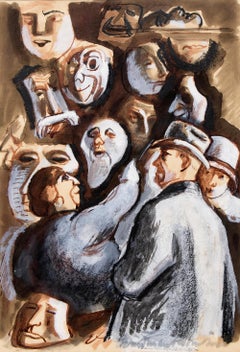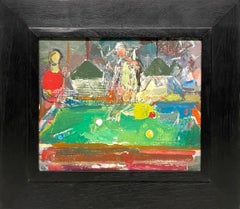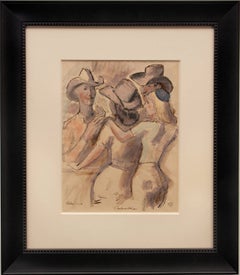Boardman Robinson Paintings
American, 1876-1952
Boardman Robinson was born in 1876 in Somerset, Nova Scotia, Canada. He came to the United States in 1894 to attend the Massachusetts Art School. He then studied painting in Paris at the Academie Colarossi and the Ecole des Beaux-Arts. After returning to the United States, Robinson worked as a cartoonist in New York City for the Morning Telegraph (1907–10), the New York Tribune (1910–14).
Robinson went with John Reed to Russia in 1915 and served as war correspondent, covering the Kerensky Revolution for the Metropolitan Magazine. From 1915-1920, he held positions at several magazines including The Masses, Liberator, and Harper’s Weekly. He also served as a one-time art editor at Vogue.
Robinson worked with Thomas Hart Benton in the 1920’s, developing a new style of mural painting. As a result, the two men are recognized as the founders of the American mural movement of the 1930’s.
In 1930, he moved to Colorado Springs and took a position at the Broadmoor Academy. The following year, he was named Director of the Academy. During this time, he influenced many other well-known artists instruct at the Academy including: George Biddle, Thomas Hart Benton, Henry Varnum Poor, Adolf Dehn, Arnold Blanch, and Edgar Britton.to
1
1
Overall Width
to
Overall Height
to
1
1
1
1
1
1
1
3
780
718
711
687
1
1
1
Artist: Boardman Robinson
Vendor of Masks, 1930s Original Modernist Gouache Painting of Carnival Scene
By Boardman Robinson
Located in Denver, CO
This captivating 1930s modernist gouache painting by Boardman Robinson (1876–1952), titled The Vendor of Masks, depicts a striking mask vendor’s display with male and female figures,...
Category
1930s American Modern Boardman Robinson Paintings
Materials
Gouache
Related Items
R.E.M. - Murmur (Grammy, Album Art, Iconic, Rock and Roll, Pop, Legendary)
By Kerry Smith
Located in Kansas City, MO
Kerry Smith
R.E.M. - Murmur
Mixed Media on Crescent board
Year: 2022
Size: 21x20in
Signed, dated by hand
COA provided
Ref.: 924802-1633
*Black frame with a mirror-gloss finish avail...
Category
2010s American Modern Boardman Robinson Paintings
Materials
Mixed Media, Acrylic, Gouache, Board
$888 Sale Price
25% Off
H 21 in W 22 in D 1 in
A Colorful, 1950s Mid-Century Modern Pool Hall Scene by Francis Chapin
By Francis Chapin
Located in Chicago, IL
A Vibrant, Colorful, 1950s Mid-Century Modern Pool Hall Scene by Notable Chicago Artist, Francis Chapin. Artwork size: 6 3/4" x 8 1/2", Oil on Masonite, Framed size: 11" x 12 1/2"....
Category
Mid-20th Century American Modern Boardman Robinson Paintings
Materials
Masonite, Oil
$950
H 11 in W 12.5 in D 1 in
Golfer Swinging, Vintage 7 Up Ad "Get Real Action" in Green and Yellow - Golf
By Bob Peak
Located in Miami, FL
This strobe-like dynamic composition with bright and bold colors reflects the energetic taste of the 7 Up brand. It lies somewhere between abstraction and figuration. Peaks' use of b...
Category
1960s American Modern Boardman Robinson Paintings
Materials
Acrylic, Illustration Board
$15,000
H 23.25 in W 21.25 in
Mid-Century Modern Abstract Geometric Trapeze Artists by Hilda Arp
By Hilda Arp
Located in Soquel, CA
Fanciful mid-century modern abstract of trapeze artists by Brooklyn artist Hilda Dora Pape Arp (b. 1909). This 1962 highly abstracted depiction of trape...
Category
1960s American Modern Boardman Robinson Paintings
Materials
Oil, Linen
$2,655
H 28 in W 22 in D 3 in
A Colorful, Dynamic 1930s Modern Boxing Scene by Chicago Artist, Francis Chapin
By Francis Chapin
Located in Chicago, IL
A Colorful, Dynamic 1930s Modern Boxing Scene by Notable Chicago Artist, Francis Chapin. Artwork size: 2 3/4 x 4 inches, oil on Masonite on original mount, framed in striking perio...
Category
Mid-20th Century American Modern Boardman Robinson Paintings
Materials
Masonite, Oil
$950
H 11 in W 12.75 in D 1.25 in
1950s "Eve" American Modern MidCentury Figurative Gouache & Oil Pastel
By Donald Stacy
Located in Arp, TX
Donald Stacy
"Eve"
c.1950s
Gouache and oil pastel on paper
14x17" black wood frame 14.75"x17.75"
Unsigned, Eve written in paint along right margin
Came from artist's estate
Donald S...
Category
Mid-20th Century American Modern Boardman Robinson Paintings
Materials
Paper, Gouache, Oil Pastel
$760 Sale Price
20% Off
H 17.75 in W 14.75 in
1950s "Curled Up Cubist" MidCentury Figurative Gouache University of Paris
By Donald Stacy
Located in Arp, TX
Donald Stacy
"Curled Up Cubist
c.1950s
Gouache on paper
24" x 18" unframed
Unsigned
Came from artist's estate
Donald Stacy (1925-2011) New Jersey
Studied: Newark School of Fine Art
The Art Students League
Pratt Graphic Arts Center
University of Paris 1953-54
University of Aix-en-Provence 1954-55
Faculty: Art Department of the New School
Museum of Modern Art
School of Visual Arts
Stacy Studio Workshop
Exhibitions: Grand Central Moderns
George Wittenborn
The New School
Print Exhibitions, Chicago
University of Oklahoma
Honolulu Museum
Monclair Museum
Wisconsin State College
Louisiana Art Commission
Philadelphia...
Category
Mid-20th Century American Modern Boardman Robinson Paintings
Materials
Paper, Gouache
Figurative Cubist Surrealist Abstraction Mid 20th Century American Modern Large
By O. Louis Guglielmi
Located in New York, NY
Figurative Cubist Surrealist Abstraction Mid 20th Century American Modern Large
O. Louis Guglielmi (1906 - 1956)
OBSESSIVE THEME
44 x 33 inches
Oil on canvas
Signed and dated '48 lo...
Category
1940s American Modern Boardman Robinson Paintings
Materials
Canvas, Oil
$50,000
H 47 in W 36 in D 2 in
Bay Area Cubist Figure in Oil on Canvas
Located in Soquel, CA
Bay Area Cubist Figure in Oil on Canvas by Ellis Hopkins (American, b. 1952).
This vibrant cubist-inspired composition depicts a seated figure abstracted into interlocking planes o...
Category
Late 20th Century American Modern Boardman Robinson Paintings
Materials
Acrylic, Canvas, Stretcher Bars
$1,200 Sale Price
20% Off
H 36 in W 25 in D 0.75 in
Vintage Expressionist Portrait of a Man with a Bowtie Oil on Wood
By Michael Pauker
Located in Soquel, CA
Expressive portrait, a caricature of a man with bowtie by Michael Pauker (American, b. 1957). Unsigned, but was acquired with a collection of the artist's work. Another version of th...
Category
Late 20th Century American Modern Boardman Robinson Paintings
Materials
Oil, Fiberboard
$1,350
H 32 in W 24 in D 0.25 in
Spiritual Origins - Geometric Abstract
By Julie Fudge
Located in Soquel, CA
Abstract oil on wood panel depicting the beginnings of the ascendancy of the Earth by Julie R. Fudge (American, 20th Century). Signed "Julie Fudge" on verso. Unframed. Image, 42"H x ...
Category
1980s American Modern Boardman Robinson Paintings
Materials
Oil, Wood Panel
"Personage" Heavy Impasto Expressionist Portrait of Lady with a Hat
Located in Soquel, CA
"Personage" Heavy Impasto Expressionist Portrait of Lady with a Hat
Abstract expressionist portrait of a woman wearing a hat by California artist Harald "Harry" Dry Schmidt (America...
Category
1970s American Modern Boardman Robinson Paintings
Materials
Canvas, Oil, Stretcher Bars
$2,150
H 21 in W 20 in D 1 in
Previously Available Items
Rodeo, Colorado
By Boardman Robinson
Located in Denver, CO
A WPA era image by renowned American muralist, Boardman Robinson. Framed dimensions measure 22 x 19.25 inches. Image measures 12.25 x 9.5 inches.
About the Artist:
Boardman Rob...
Category
1930s Other Art Style Boardman Robinson Paintings
Materials
Mixed Media
Boardman Robinson paintings for sale on 1stDibs.
Find a wide variety of authentic Boardman Robinson paintings available for sale on 1stDibs. You can also browse by medium to find art by Boardman Robinson in gouache, paint, watercolor and more. Much of the original work by this artist or collective was created during the 1930s and is mostly associated with the modern style. Not every interior allows for large Boardman Robinson paintings, so small editions measuring 16 inches across are available. Customers who are interested in this artist might also find the work of Donald Stacy, Jack Hooper, and Harold von Schmidt. Boardman Robinson paintings prices can differ depending upon medium, time period and other attributes. On 1stDibs, the price for these items starts at $1,195 and tops out at $1,195, while the average work can sell for $1,195.


